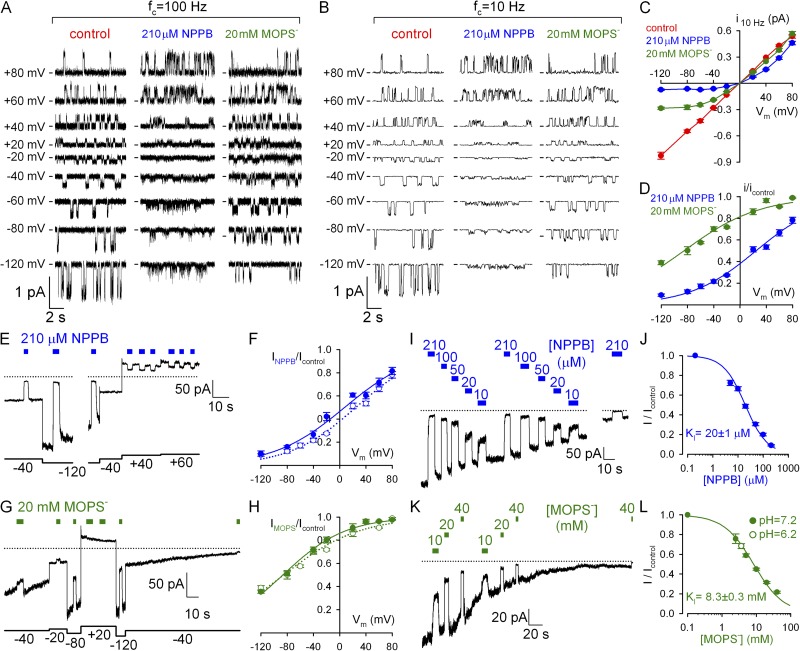Figure 1.
Voltage and dose dependence of pore block by NPPB and MOPS−. (A and B) Unitary WT CFTR currents in symmetrical ∼140-mM Cl− with and without cytosolically applied blockers, displayed at two bandwidths (fc, filter corner frequency). We could not reliably discern two distinct conductance levels in MOPS− (Gunderson and Kopito, 1995). (C) Apparent unitary amplitudes at 10 Hz, with and without blockers, plotted against voltage. (D) Fractional unitary current in 210 µM NPPB and 20 mM MOPS− (symbols) and Boltzmann fits (solid lines); midpoint voltages (V1/2) and apparent valences (z) were V1/2 = −85 ± 3 mV and z = −0.45 ± 0.03 for MOPS− and V1/2 = 24 ± 2 mV and z = −0.51 ± 0.03 for NPPB. (E, G, I, and K) Slowly decaying macroscopic ”locked-open” currents of E1371S CFTR in the absence of bath ATP; brief applications of 210 µM NPPB or 20 mM MOPS− at various voltages (E and G) or of various blocker concentrations at −120 mV (I and K). Dotted lines show zero-current levels estimated from final segments; in E and G, small (<1 pA/40 mV) linear seal currents were subtracted. (F and H) Voltage dependence of macroscopic current block by (F) 210 µM NPPB and (H) 20 mM MOPS− (closed symbols) and Boltzmann fits (solid lines); V1/2 = −87 ± 3 mV and z = −0.54 ± 0.07 for MOPS− and V1/2 = 7 ± 3 mV and z = −0.48 ± 0.03 for NPPB; open symbols and dotted lines replotted from panel D. (J and L) Dose dependence of macroscopic current block by (J) NPPB and (L) MOPS− at −120 mV (closed symbols) and Michaelis–Menten fits (solid lines). Open symbol in L: block by 40 mM of total MOPS (MOPS-H plus MOPS−) at pH 6.2; calculated [MOPS−] = 3.6 mM: fractional block by MOPS depends on [MOPS−], not total [MOPS], confirming anionic MOPS− to be responsible for pore block (Ishihara and Welsh, 1997).

